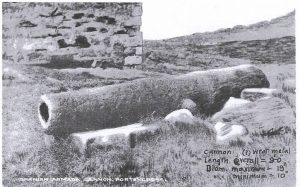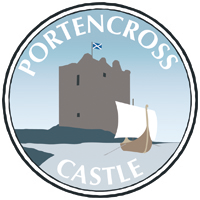A cannon has been at the Castle since the 1740s. There is a sunken Spanish galleon off Portencross (wreck No 4084). Sir Archibald Grant, and a Captain Roe began a search for the wreck in August, 1740. The divers stated that the ‘country folk’ told them the location. The divers searched the water using ropes stretched between two vessels with lead weights dragging along the seabed. The wreck is about 400 metres from the shore in around 20 metres of water. It contained many guns but was covered in sand. The divers used large tongs and brought up ten iron and ten brass cannons.

The brass cannons had been made in England and had made their way to Spain via France. The writing on the brass cannons read: Richard and John Phillips …. 1584. The E. R. on the cannon, confirmed it was English. Even in those days, there appeared to have been a thriving international arms trade. A report in 1956 noted that, in the 1800s, people could make out a coat of arms, perhaps a Spanish crown, on the Portencross iron cannon.
Another cannon from the wrecked Armada ship can be found at the McLean Museum in Greenock (see below).
It may be that the wreck was kept secret to give the survivors a better chance to return to Spain. The Boyds of Portencross supported Mary Queen of Scots at the time and may have been sympathetic to the Spanish. The Portencross wreck is possibly one of the following: the Santiago (but perhaps it sank off Co Mayo, Ireland); the San Pedro; the San Juan; the San Bartolome; the San Maria del Junca; the Barca de Danzig; or even the Santa Barbara.
In August 2007, the seabed at Portencross was surveyed and researchers found some magnetic anomalies. In the future, we may be able to mount a further, more detailed search for the galleon. Meantime, its location remains a secret to the villagers.

.JPG)